by Andy | Nov 17, 2013
Hello!
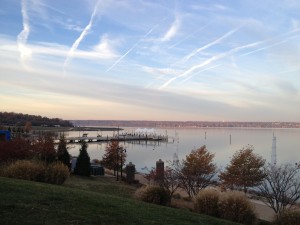
Earlier this evening, I returned to Ann Arbor from the 2013 Interim Meeting of the American Medical Association, Medical Student Section. The AMA represents medical professionals all the way from medical school to retirement, and it was a privilege to initiate my first experience with this fantastic organization. I spent a few days in National Harbor, MD, about 10 miles south of Washington D.C. and just across the bridge from Alexandria, VA, with eight of my classmates (6 M1’s, 2 M2’s). While I missed out on last year’s Interim Meeting in Hawaii, AMA still picked a beautiful place to hold a gathering of hundreds of medical students representing nearly every allopathic & osteopathic school in the US. Hawaii is on the radar for 2017 nonetheless.
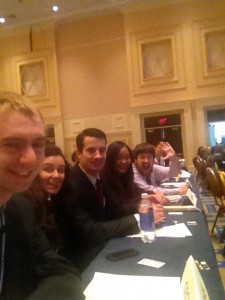
The primary goals of the Interim Meeting were three-fold: 1) Discuss, rewrite, and approve/deny “resolutions” (see below), 2) Elect new leadership for each region of the AMA (Michigan is in Region V), and 3) meet and learn from accomplished upperclass medical students, residents, and attending physicians.
On the left is a picture of our group at the Region V meeting yesterday afternoon, at which we connected with delegates and other representatives from MSU, Wayne State, OSU, and several other nearby schools. As for the resolutions, AMA members from any school can submit proposals for new policy or current policy revisions, concerning health care at large or opportunities within medical schools and the AMA-MSS itself. For broader-impact changes, delegates from each school gather to vote, and those resolutions that are approved by MSS are reviewed and voted on at the main AMA meeting, which starts shortly after the medical student part of the conference. As an M1 new to the AMA, I couldn’t directly vote at this meeting (the M1s voiced political views through our chapter’s president, a current M2), but through continued involvement and my growing fascination with politics, I’m excited for the Annual Meeting in Chicago and next year’s Interim Meeting in Dallas.
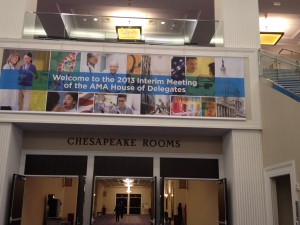
A few of my big takeaways from the conference and from this morning’s keynote speaker, Georgia’s US Representative Tom Price, M.D. (also a graduate of the University of Michigan Medical School — Go Blue!), were that advocacy and politics are essential (and inescapable) parts of medicine, and also to stay active with your county, state, and regional medical societies. For our team, that would be the Washtenaw County Medical Society, the MSMS, and Region V of the AMA!
During the trip we did explore a bit of the surrounding area, including the U.S. Capitol!
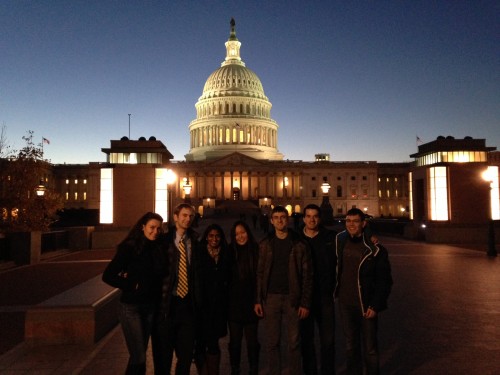
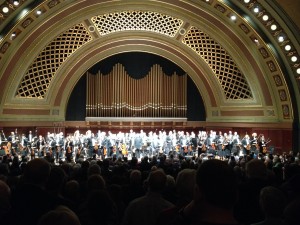 Upon returning to Ann Arbor, I had just enough time to make it to Hill Auditorium for a performance of Mahler’s 9th Symphony by the San Francisco Symphony, the finale for their 2013 tour and led by the esteemed conductor Michael Tilson Thomas. I previously enjoyed performances of Mahler’s 2nd and 5th Symphonies by the Dartmouth Symphony Orchestra during my freshman and senior years of undergrad, and tonight’s performance puts me closer to “collecting” all nine breathtaking experiences of Mahler’s masterpieces, live. Going to concerts and thinking about music as my main focus rather than it playing in the background while studying was in a way artistically nostalgic and an excellent break from the hustle of medical school. This was my first time in Hill since the White Coat Ceremony, and I was pleasantly reminded of the value of and opportunities to pursue the arts here in Ann Arbor.
Upon returning to Ann Arbor, I had just enough time to make it to Hill Auditorium for a performance of Mahler’s 9th Symphony by the San Francisco Symphony, the finale for their 2013 tour and led by the esteemed conductor Michael Tilson Thomas. I previously enjoyed performances of Mahler’s 2nd and 5th Symphonies by the Dartmouth Symphony Orchestra during my freshman and senior years of undergrad, and tonight’s performance puts me closer to “collecting” all nine breathtaking experiences of Mahler’s masterpieces, live. Going to concerts and thinking about music as my main focus rather than it playing in the background while studying was in a way artistically nostalgic and an excellent break from the hustle of medical school. This was my first time in Hill since the White Coat Ceremony, and I was pleasantly reminded of the value of and opportunities to pursue the arts here in Ann Arbor.
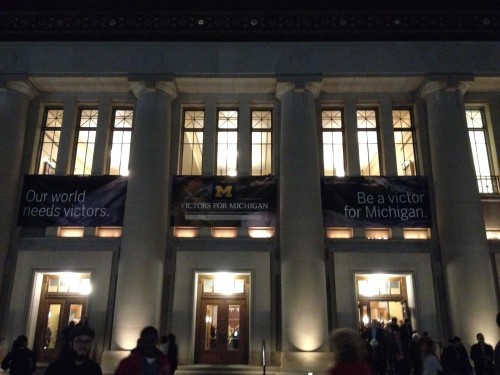
Also, I finally made it to a one-of-a-kind Michigan football game last week! Despite the loss to Nebraska and the end of Brady Hoke’s home winning streak, the Wolverines redeemed themselves against Northwestern in a 3OT thriller earlier today. Here’s my obligatory Big House photo from last week:
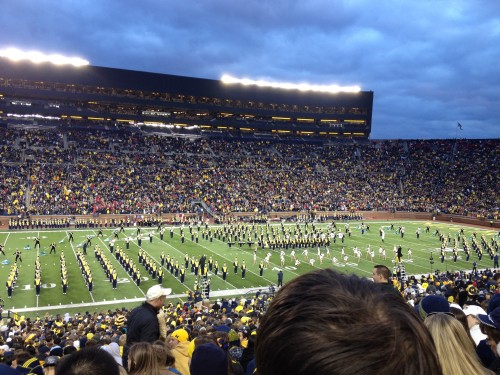
Back to studying for MSK! I have the option to defer my quiz for this week until Mon/Tues because of the conference, but I’ll hopefully finish studying and quiz soon!
-Andy
PS- To those who traveled with me to AMA, thank you for making it an awesome trip! Bonding with my classmates is so much fun.
by Andy | Oct 28, 2013
Hello!
The M1s are now 3 weeks into our Cardiovascular & Respiratory sequence, and overall our class has really enjoyed the variety and clinical applications presented throughout the course. We’ve had some incredible lecturers, including Dr. Robert Bartlett (inventor of the incentive spirometer and also PI of the lab that invented the ECMO heart-lung machine), as well as a very eye-opening Multidisciplinary Conference on heart failure, which featured a series of three short talks by a pathologist, cardiologist, and cardiothoracic surgeon followed by a presentation by a patient who had a very successful heart transplant just two months prior. In anatomy, we’ve now removed the heart and lungs from our donors and closely examined the intricacies that were so foreign to us just a few weeks ago. We also learned how and where to listen to the heart, and learned a bit about different heart sounds throughout the sequence (much more to come M2 year!), which allows us to intelligently use the stethoscopes we’ve been storing since our White Coat Ceremony. This seamlessly leads me to the second part of this post…
This past Saturday, I volunteered at the UM Student-Run Free Clinic for the first time. Each pre-clinical student (M1/M2) is paired with a clinical student (M3/M4), and your team sees 3-4 patients during the afternoon. I was able to successfully take each patient’s vitals, and these were truly important baby steps toward taking care of patients. We learned during our first Clinical Foundations of Medicine week how to interview a patient and organize a History of Present Illness, and it was a challenging but rewarding experience really applying this new skill in a clinical context. Any holes I missed were filled in by my clinical student mentor, and the two of us presented each patient to one of the attending physicians also volunteering at the clinic that afternoon. The physician completed the consult alongside our medical student team, and we helped review instructions & prescription medications with each patient prior to discharge. Admittedly, “playing doctor” was a bit more nerve wracking than I first imagined, but with more experience in our Standardized Patient Program (part of CFM) combined with learning from the amazing mentors we have at UM, I can keep working toward the exciting prospects of M3 year!
-Andy
by Andy | Oct 4, 2013
Dear readers,
Since my last post, our class has completed Cells & Tissues, and we’re about to finish our first Clinical Foundations of Medicine (CFM) week. Cells & Tissues gave us a taste of the next several sequences: our more traditional lecture-based “undergraduate-style” learning complemented by Anatomy and Histology, two very visually-oriented and well-integrated components of our curriculum.
Last Friday, we had our first official anatomy practical, a 1 minute/question multiple-choice exam that takes each student to a number of stations with short questions or vignettes and associated visuals (labeled bones, labeled structures in cadavers, or labeled radiographic images). This style ensures you can translate your knowledge from the textbooks to the human body, and also think quickly on your feet. Even after only three dissections, the number of structures/concepts added up quickly, but we’re all really enjoying the experience.
During our CFM week, we’ve had sessions on health disparities, health economics, integrative medicine, geriatric care, issues surrounding end-of-life care, and how to thoroughly take a patient’s social history. All of these sessions set us up for our four field trips of the week: a clinic visit, a complementary & alternative medicine visit, a senior visit, and a health disparities visit.
For my clinic visit, I spent an afternoon shadowing in the Emergency Department, and I was able to see cases ranging from strokes and burn victims to other major physical trauma and psychiatric emergency care. While we were instructed specifically to watch how doctors interacted with patients (to help develop our medical interviewing skills and establish rapport with patients), having a completely new shadowing experience was very valuable. I also visited Body Conscious, a therapeutic massage parlor just outside of the UM campus, and learned that licensed massage therapists have a working knowledge of musculoskeletal anatomy on par with anatomy instructors! Everyone in my group got a free massage, and it was really interesting to learn the techniques they use to relax and extend the range of motion in different muscles. My other two visits this week were to the Home of New Vision, a nonprofit in Ypsilanti dedicated to helping people recover from drug and alcohol addictions, as well as a nearby senior living center for elderly citizens with dementia and Alzheimer’s Disease.
UMMS highly values preparing well-rounded, empathetic physicians, and to plant 172 students in four unique locations during a single week a) requires a ton of logistical planning (a quick shout-out to the CFM staff for making this week possible) and b) really gives us practical first-hand experiences that we can take as we move forward into our clinical training. Our next CFM week is right after Thanksgiving, and we’ll start learning physical exam skills and the more standard “med school” skills. I won’t forget the diverse populations I’ve met this week and the advice imparted to me.
Next up, a month of Cardiovascular/Respiratory! And a quiz-free October weekend for apple picking and a cider mill trip!
-Andy
by Andy | Aug 31, 2013
Dear readers,
It’s been an exciting time as the M1s have just about finished Patients & Populations–with 3 exams to take between this past Thursday afternoon and Monday evening, we’ve basically taken over the LRC (or some of my ambitious classmates completed all three exams early to get in a four-day weekend). After a short stop home, I will be back in Ann Arbor by Monday to close out the sequence with my remaining two exams. Before we know it, Cells & Tissues will begin, as well as our long-awaited anatomy labs!
Since I last wrote, our class has had a number of exciting happenings. We launched our Family-Centered Experience program, which pairs two medical students with a family that has endured a chronic illness to allow us to begin to understand the patient’s perspective in health care. All of the M1s, many of the families, and all of our FCE group facilitators (attending physicians) gathered at a hotel a few miles off campus for a banquet to commemorate the significance of this adventure, both for the M1s and for the volunteers.
Additionally, we had our Student Activities fair, where many booths were set up around the circle drive outside Med Sci I, with representatives ranging from M2s to residents and attending physicians. Like many of my classmates, I came to Michigan with very broad interests, so the countless opportunities in all disciplines allow us to try a little of everything! The next few years are about finding our true passions and discovering what we will enjoy waking up and doing every day. Even if that means signing up for the email lists of 100+ organizations.
Anyways, the Michigan summer weather is still very warm and sunny, and football season begins today, so it’s an exciting time to be a Michigan Wolverine! Go Blue!
-Andy
by Andy | Aug 20, 2013
Dear readers,
This past weekend, our M1 class completed our first “Patients and Populations” quiz! For those who haven’t heard, UMMS has a “flextime quiz” system, which basically means you can log onto a computer in our Learning Resource Center or our student lounge and take a ~40-question multiple choice quiz anytime between 5pm on Friday afternoon and 11pm (start time) on Sunday evening. Early quizzers open up the weekend for relaxation, travel, and fun activities, while later quizzers can pack more into their week and use the weekend to do a lot of preparation and review. There’s a spectrum of study techniques, of course, but these are the two extremes. I personally took the quiz Sunday at around 1:30pm, had Sunday afternoon off to relax and visit Zingerman’s Delicatessen for a post-quiz celebratory lunch, and also went out for more celebration and ice cream at the Washtenaw Dairy with a group of ~30 M1s that evening (med students travel in packs as you’ll learn).
More about the quizzes for those who are curious: because the USMLE Step 1 is a computer-based & multiple choice exam, it’s actually really great that we’re specifically preparing for this test format during our pre-clerkship years rather than continuing the college-style pencil/paper exams with endless free-response sections. One concern that some students had coming in was the frequency of quizzes–we basically have a quiz or a final exam for a “sequence” (3-5 weeks of a particular topic, also called a “block” at other schools) every weekend (except Thanksgiving/winter/spring breaks), which makes for frequent review and check-up on a week’s worth of material. It sounds intense in theory, but with Michigan’s truly Pass/Fail grading system, the pressure to get the highest score possible is alleviated (note: the mean score for our first quiz was about a 92%, so our class still performs overall beyond the minimum requirements to pass (75%) because of the environment of intellectual curiosity and shared passion for learning, but the comfort zone is going to be nice to have this year). Real (tiered) grades will hit us in two years on the wards, but for now, we’re still acclimating to Ann Arbor, learning best practices for studying in medical school, and enjoying the rest of the summer!
-Andy


 Upon returning to Ann Arbor, I had just enough time to make it to Hill Auditorium for a performance of Mahler’s 9th Symphony by the San Francisco Symphony, the finale for their 2013 tour and led by the esteemed conductor Michael Tilson Thomas. I previously enjoyed performances of Mahler’s 2nd and 5th Symphonies by the Dartmouth Symphony Orchestra during my freshman and senior years of undergrad, and tonight’s performance puts me closer to “collecting” all nine breathtaking experiences of Mahler’s masterpieces, live. Going to concerts and thinking about music as my main focus rather than it playing in the background while studying was in a way artistically nostalgic and an excellent break from the hustle of medical school. This was my first time in Hill since the White Coat Ceremony, and I was pleasantly reminded of the value of and opportunities to pursue the arts here in Ann Arbor.
Upon returning to Ann Arbor, I had just enough time to make it to Hill Auditorium for a performance of Mahler’s 9th Symphony by the San Francisco Symphony, the finale for their 2013 tour and led by the esteemed conductor Michael Tilson Thomas. I previously enjoyed performances of Mahler’s 2nd and 5th Symphonies by the Dartmouth Symphony Orchestra during my freshman and senior years of undergrad, and tonight’s performance puts me closer to “collecting” all nine breathtaking experiences of Mahler’s masterpieces, live. Going to concerts and thinking about music as my main focus rather than it playing in the background while studying was in a way artistically nostalgic and an excellent break from the hustle of medical school. This was my first time in Hill since the White Coat Ceremony, and I was pleasantly reminded of the value of and opportunities to pursue the arts here in Ann Arbor.



